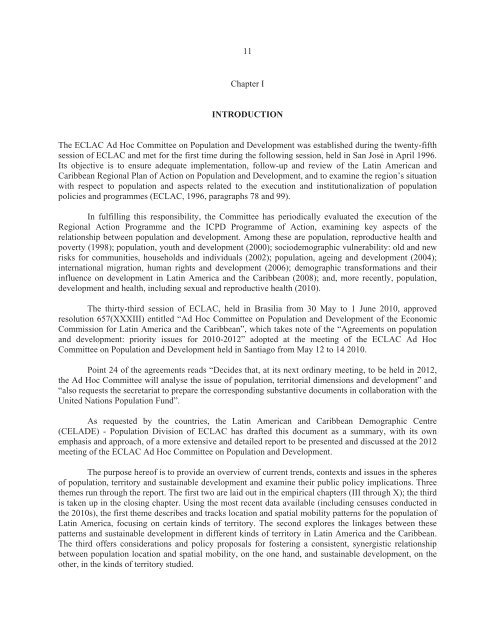Population, territory and sustainable development
The purpose of this document is to provide an overview of current trends, contexts and issues in the spheres of population, territory and sustainable development and examine their public policy implications. Three themes run through the report. The first two are laid out in the empirical chapters (III through X); the third is taken up in the closing chapter. Using the most recent data available (including censuses conducted in the 2010s), the first theme describes and tracks location and spatial mobility patterns for the population of Latin America, focusing on certain kinds of territory. The second explores the linkages between these patterns and sustainable development in different kinds of territory in Latin America and the Caribbean. The third offers considerations and policy proposals for fostering a consistent, synergistic relationship between population location and spatial mobility, on the one hand, and sustainable development, on the other, in the kinds of territory studied.
The purpose of this document is to provide an overview of current trends, contexts and issues in the spheres of population, territory and sustainable development and examine their public policy implications. Three themes run through the report. The first two are laid out in the empirical chapters (III through X); the third is taken up in the closing chapter. Using the most recent data available (including censuses conducted in the 2010s), the first theme describes and tracks location and spatial mobility patterns for the population of Latin America, focusing on certain kinds of territory. The second explores the linkages between these patterns and sustainable development in different kinds of territory in Latin America and the Caribbean. The third offers considerations and policy proposals for fostering a consistent, synergistic relationship between population location and spatial mobility, on the one hand, and sustainable development, on the other, in the kinds of territory studied.
Create successful ePaper yourself
Turn your PDF publications into a flip-book with our unique Google optimized e-Paper software.
11<br />
Chapter I<br />
INTRODUCTION<br />
The ECLAC Ad Hoc Committee on <strong>Population</strong> <strong>and</strong> Development was established during the twenty-fifth<br />
session of ECLAC <strong>and</strong> met for the first time during the following session, held in San José in April 1996.<br />
Its objective is to ensure adequate implementation, follow-up <strong>and</strong> review of the Latin American <strong>and</strong><br />
Caribbean Regional Plan of Action on <strong>Population</strong> <strong>and</strong> Development, <strong>and</strong> to examine the region’s situation<br />
with respect to population <strong>and</strong> aspects related to the execution <strong>and</strong> institutionalization of population<br />
policies <strong>and</strong> programmes (ECLAC, 1996, paragraphs 78 <strong>and</strong> 99).<br />
In fulfilling this responsibility, the Committee has periodically evaluated the execution of the<br />
Regional Action Programme <strong>and</strong> the ICPD Programme of Action, examining key aspects of the<br />
relationship between population <strong>and</strong> <strong>development</strong>. Among these are population, reproductive health <strong>and</strong><br />
poverty (1998); population, youth <strong>and</strong> <strong>development</strong> (2000); sociodemographic vulnerability: old <strong>and</strong> new<br />
risks for communities, households <strong>and</strong> individuals (2002); population, ageing <strong>and</strong> <strong>development</strong> (2004);<br />
international migration, human rights <strong>and</strong> <strong>development</strong> (2006); demographic transformations <strong>and</strong> their<br />
influence on <strong>development</strong> in Latin America <strong>and</strong> the Caribbean (2008); <strong>and</strong>, more recently, population,<br />
<strong>development</strong> <strong>and</strong> health, including sexual <strong>and</strong> reproductive health (2010).<br />
The thirty-third session of ECLAC, held in Brasilia from 30 May to 1 June 2010, approved<br />
resolution 657(XXXIII) entitled “Ad Hoc Committee on <strong>Population</strong> <strong>and</strong> Development of the Economic<br />
Commission for Latin America <strong>and</strong> the Caribbean”, which takes note of the “Agreements on population<br />
<strong>and</strong> <strong>development</strong>: priority issues for 2010-2012” adopted at the meeting of the ECLAC Ad Hoc<br />
Committee on <strong>Population</strong> <strong>and</strong> Development held in Santiago from May 12 to 14 2010.<br />
Point 24 of the agreements reads “Decides that, at its next ordinary meeting, to be held in 2012,<br />
the Ad Hoc Committee will analyse the issue of population, territorial dimensions <strong>and</strong> <strong>development</strong>” <strong>and</strong><br />
“also requests the secretariat to prepare the corresponding substantive documents in collaboration with the<br />
United Nations <strong>Population</strong> Fund”.<br />
As requested by the countries, the Latin American <strong>and</strong> Caribbean Demographic Centre<br />
(CELADE) - <strong>Population</strong> Division of ECLAC has drafted this document as a summary, with its own<br />
emphasis <strong>and</strong> approach, of a more extensive <strong>and</strong> detailed report to be presented <strong>and</strong> discussed at the 2012<br />
meeting of the ECLAC Ad Hoc Committee on <strong>Population</strong> <strong>and</strong> Development.<br />
The purpose hereof is to provide an overview of current trends, contexts <strong>and</strong> issues in the spheres<br />
of population, <strong>territory</strong> <strong>and</strong> <strong>sustainable</strong> <strong>development</strong> <strong>and</strong> examine their public policy implications. Three<br />
themes run through the report. The first two are laid out in the empirical chapters (III through X); the third<br />
is taken up in the closing chapter. Using the most recent data available (including censuses conducted in<br />
the 2010s), the first theme describes <strong>and</strong> tracks location <strong>and</strong> spatial mobility patterns for the population of<br />
Latin America, focusing on certain kinds of <strong>territory</strong>. The second explores the linkages between these<br />
patterns <strong>and</strong> <strong>sustainable</strong> <strong>development</strong> in different kinds of <strong>territory</strong> in Latin America <strong>and</strong> the Caribbean.<br />
The third offers considerations <strong>and</strong> policy proposals for fostering a consistent, synergistic relationship<br />
between population location <strong>and</strong> spatial mobility, on the one h<strong>and</strong>, <strong>and</strong> <strong>sustainable</strong> <strong>development</strong>, on the<br />
other, in the kinds of <strong>territory</strong> studied.


















